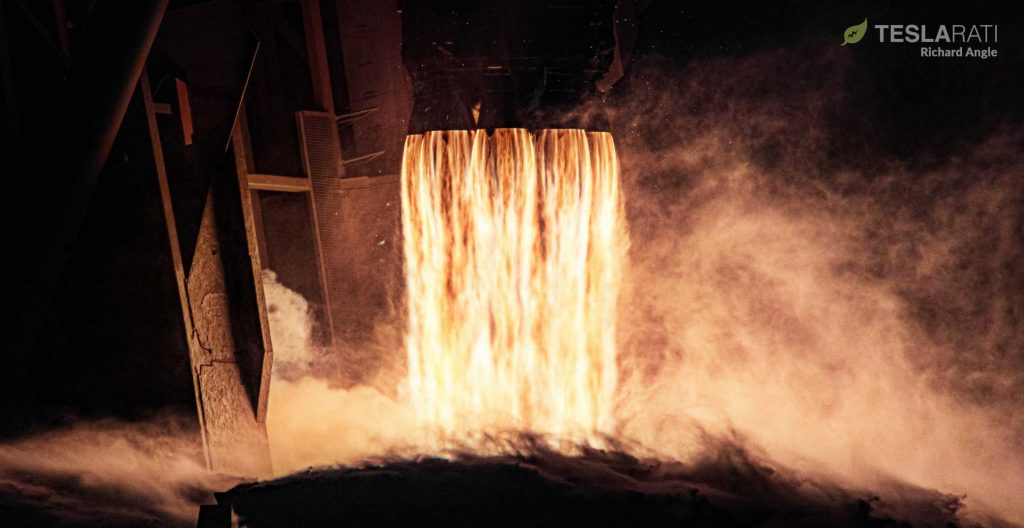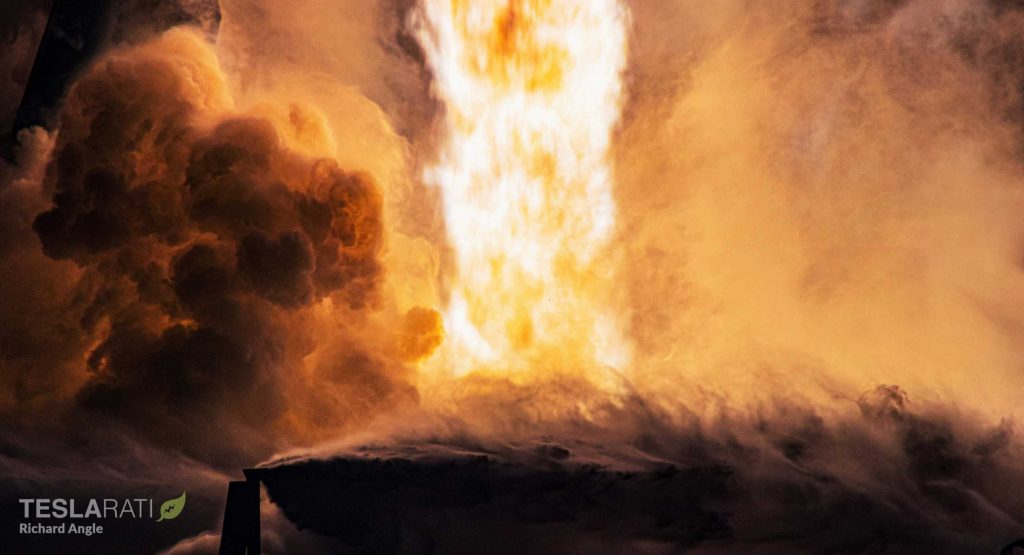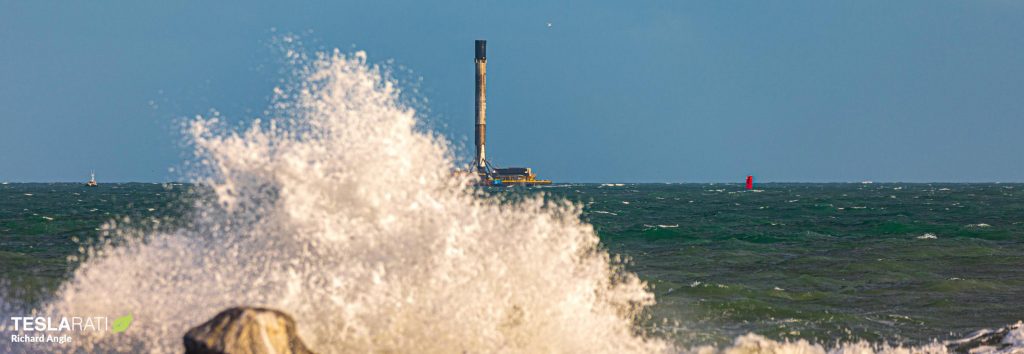

News
SpaceX Falcon 9 greeted by iconic Florida sunset after first rocket landing of the decade
After completing its fourth flawless orbital-class launch and landing in 16 months, SpaceX’s latest reusable Falcon 9 rocket has successfully returned to dry land and was greeted by a spectacular Florida sunset during its port arrival.
Safely secured aboard drone ship Of Course I Still Love You (OCISLY) by SpaceX’s famous Octagrabber robot, which uses claws its tank-like heft to physically hold the rocket down, Falcon 9 booster B1049 passed through the mouth of Port Canaveral on January 9th. This effectively marked the end of its third drone ship recovery and fourth landing overall since its orbital-class launch debut in September 2018, averaging a SpaceX launch every four months.
B1049.4 supported SpaceX’s second launch of upgraded Starlink v1.0 communications satellites and the 60 spacecraft it helped send to orbit almost certainly catapulted the company into the position of owning the world’s largest private satellite constellation – now measuring some 175 operational spacecraft strong. Those 60 new Starlink satellites have since deployed their solar arrays, performed basic systems checkouts, activated their krypton-fueled ion thrusters, and begun raising their orbits to around 350 km (220 mi). After arriving at 350 km, SpaceX will carefully analyze the performance of each satellite and send all healthy spacecraft to their final operational altitude of 550 km (340 mi).
Teslarati photographer Richard Angle was present for both sides of Falcon 9 B1049’s fourth orbital-class launch and landing, capturing the booster’s January 6th liftoff from Cape Canaveral Air Force Station Launch Complex 40 (CCAFS LC-40) and its January 9th Port Canaveral arrival aboard drone ship OCISLY. Given the spectacular Florida sunset that greeted the rocket, B1049 clearly has a preferred color palette – fire.



Falcon 9 B1049 is powered by nine Merlin 1D engines capable of burning liquid oxygen and refined kerosene (RP-1) to produce a maximum thrust of 7600 kN (1.7 million lbf), giving it a thrust to weight ratio of more than 1.4 even when fully loaded with some 525 metric tons (1.2 million lb) of propellant.
According to SpaceX and CEO Elon Musk, Falcon 9’s newest Block 5 boosters – debuted in May 2018 and expected to be the last major upgrade to the family – are designed to be capable of at least 10 orbital-class launches each. A step further, they could potentially be able to perform dozens of missions before retirement is unavoidable, although that would reportedly require the same sort of in-depth overhauls that are routine for modern airliners. Regardless of SpaceX’s aspirations of 10-100 flights per booster, the company is making great progress but undeniably has a long ways to go.



Still, it’s not actually as long as it may seem. On January 6th, Falcon 9 B1049 became the second SpaceX booster to successfully launch four times, following in the footsteps of B1048’s record-breaking fourth flight – completed in November 2019. Now in possession of two consecutively-built Falcon 9 boosters with four flights under each of their belts, SpaceX should be able to quickly determine whether its fleet of reusable rockets can be trusted with four launches (and more).
Additionally, after two months for technicians and engineers to inspect and repair the booster, B1048 could be ready for its fifth launch far sooner than later. SpaceX wrapped up B1049’s fourth post-recovery processing on January 13th – a relatively brisk three and a half days from port arrival to horizontal transport. The booster was moved to one of SpaceX’s many Cape Canaveral hangars, where – just like B1048 – it will be inspected, refurbished, and turned around for its fifth launch sometime in the near future.
Check out Teslarati’s Marketplace! We offer Tesla accessories, including for the Tesla Cybertruck and Tesla Model 3.
News
Tesla begins Robotaxi certification push in Arizona: report
Tesla seems serious about expanding its Robotaxi service to several states in the coming months.

Tesla has initiated discussions with Arizona transportation regulators to certify its driverless Robotaxi service in the state, as per a recent report from Bloomberg News. The move follows Tesla’s launch of its Robotaxi pilot program in Austin, Texas, as well as CEO Elon Musk’s recent comments about the service’s expansion in the Bay Area.
The Arizona Department of Transportation confirmed to Bloomberg that Tesla has reached out to begin the certification process for autonomous ride-sharing operations in the state. While details remain limited, the outreach suggests that Tesla is serious about expanding its driverless Robotaxi service to several territories in the coming months.
The Arizona development comes as Tesla prepares to expand its service area in Austin this weekend, as per CEO Elon Musk in a post on X. Musk also stated that Tesla is targeting the San Francisco Bay Area as its next major market, with a potential launch “in a month or two,” pending regulatory approvals.
Tesla first launched its autonomous ride-hailing program on June 22 in Austin with a small fleet of Model Y vehicles, accompanied by a Tesla employee in the passenger seat to monitor safety. While still classified as a test, Musk has said the program will expand to about 1,000 vehicles in the coming months. Tesla will later upgrade its Robotaxi fleet with the Cyercab, a two-seater that is designed without a steering wheel.
Sightings of Cybercab castings around the Giga Texas complex suggests that Tesla may be ramping the initial trial production of the self-driving two-seater. Tesla, for its part, has noted in the past that volume production of the Cybercab is expected to start sometime next year.
In California, Tesla has already applied for a transportation charter-party carrier permit from the state’s Public Utilities Commission. The company is reportedly taking a phased approach to operating in California, with the Robotaxi service starting with pre-arranged rides for employees in vehicles with safety drivers.
News
Tesla sets November 6 date for 2025 Annual Shareholder Meeting
The automaker announced the date on Thursday in a Form 8-K.

Tesla has scheduled its 2025 annual shareholder meeting for November 6, addressing investor concerns that the company was nearing a legal deadline to hold the event.
The automaker announced the date on Thursday in a Form 8-K submitted to the United States Securities and Exchange Commission (SEC). The company also listed a new proposal submission deadline of July 31 for items to be included in the proxy statement.
Tesla’s announcement followed calls from a group of 27 shareholders, including the leaders of large public pension funds, which urged Tesla’s board to formally set the meeting date, as noted in a report from The Wall Street Journal.
The group noted that under Texas law, where Tesla is now incorporated, companies must hold annual meetings within 13 months of the last one if requested by shareholders. Tesla’s previous annual shareholder meeting was held on June 13, 2024, which placed the July 13 deadline in focus.
Tesla originally stated in its 2024 annual report that it would file its proxy statement by the end of April. However, an amended filing on April 30 indicated that the Board of Directors had not yet finalized a meeting date, at least at the time.
The April filing also confirmed that Tesla’s board had formed a special committee to evaluate certain matters related to CEO Elon Musk’s compensation plan. Musk’s CEO performance award remains at the center of a lengthy legal dispute in Delaware, Tesla’s former state of incorporation.
Due to the aftermath of Musk’s legal dispute about his compensation plan in Delaware, he has not been paid for his work at Tesla for several years. Musk, for his part, has noted that he is more concerned about his voting stake in Tesla than his actual salary.
At last year’s annual meeting, TSLA shareholders voted to reapprove Elon Musk’s compensation plan and ratified Tesla’s decision to relocate its legal domicile from Delaware to Texas.
Elon Musk
Grok coming to Tesla vehicles next week “at the latest:” Elon Musk
Grok’s rollout to Tesla vehicles is expected to begin next week at the latest.

Elon Musk announced on Thursday that Grok, the large language model developed by his startup xAI, will soon be available in Tesla vehicles. Grok’s rollout to Tesla vehicles is expected to begin next week at the latest, further deepening the ties between the two Elon Musk-led companies.
Tesla–xAI synergy
Musk confirmed the news on X shortly after livestreaming the release of Grok 4, xAI’s latest large language model. “Grok is coming to Tesla vehicles very soon. Next week at the latest,” Musk wrote in a post on social media platform X.
During the livestream, Musk and several members of the xAI team highlighted several upgrades to Grok 4’s voice capabilities and performance metrics, positioning the LLM as competitive with top-tier models from OpenAI and Google.
The in-vehicle integration of Grok marks a new chapter in Tesla’s AI development. While Tesla has long relied on in-house systems for autonomous driving and energy optimization, Grok’s integration would introduce conversational AI directly into its vehicles’ user experience. This integration could potentially improve customer interaction inside Tesla vehicles.
xAI and Tesla’s collaborative footprint
Grok’s upcoming rollout to Tesla vehicles adds to a growing business relationship between Tesla and xAI. Earlier this year, Tesla disclosed that it generated $198.3 million in revenue from commercial, consulting, and support agreements with xAI, as noted in a report from Bloomberg News. A large portion of that amount, however, came from the sale of Megapack energy storage systems to the artificial intelligence startup.
In July 2023, Musk polled X users about whether Tesla should invest $5 billion in xAI. While no formal investment has been made so far, 68% of poll participants voted yes, and Musk has since stated that the idea would be discussed with Tesla’s board.
-

 Elon Musk1 week ago
Elon Musk1 week agoTesla investors will be shocked by Jim Cramer’s latest assessment
-

 Elon Musk19 hours ago
Elon Musk19 hours agoxAI launches Grok 4 with new $300/month SuperGrok Heavy subscription
-

 Elon Musk3 days ago
Elon Musk3 days agoElon Musk confirms Grok 4 launch on July 9 with livestream event
-

 News7 days ago
News7 days agoTesla Model 3 ranks as the safest new car in Europe for 2025, per Euro NCAP tests
-

 Elon Musk2 weeks ago
Elon Musk2 weeks agoA Tesla just delivered itself to a customer autonomously, Elon Musk confirms
-

 Elon Musk1 week ago
Elon Musk1 week agoxAI’s Memphis data center receives air permit despite community criticism
-

 Elon Musk2 weeks ago
Elon Musk2 weeks agoTesla’s Omead Afshar, known as Elon Musk’s right-hand man, leaves company: reports
-

 News2 weeks ago
News2 weeks agoXiaomi CEO congratulates Tesla on first FSD delivery: “We have to continue learning!”

















